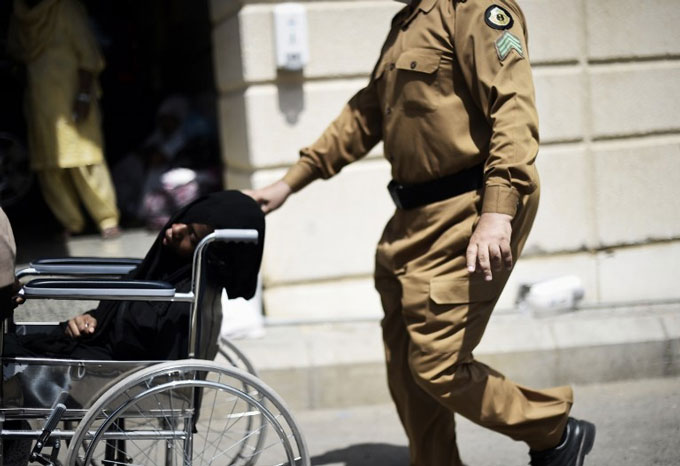Shari’ah doesn’t obligate disabled Muslims to perform hajj. Nevertheless, a strong desire to make this spiritual journey pulls on the heartstrings of every Muslim.
In past ages, the physical challenge of Hajj was far more rigorous than our air-conditioned era of comfortable accommodations.
Nowadays, compassionate attention to the needs of disabled Muslims means that more and more Muslims are able to fulfill their dream of performing Hajj.
Dedicated to Disabled Pilgrims
Beyond the normal travel/visa regulations, every pilgrim must comply with, there are more travel agencies and services than ever available for disabled pilgrims wishing to make Hajj.
The level of assistance required by a disabled pilgrim will determine if a dedicated travel agency is required. In all cases, travel arrangements and assistance for any disabled pilgrim must be made carefully.
For pilgrims not fully wheelchair-bound, nearly all Hajj travel agencies and services can accommodate disabled pilgrims with limited physical abilities, such as boarding buses, and ascending/descending stairs. Online reports are encouraging, regarding the variety of disability services available.
Pilgrims requiring full-time wheelchair service and assistance will be better served by a dedicated travel agency. Caregivers providing for individual needs of each pilgrim in their group.
For example, Disabled Hajj services have been offered since 2000 by the UK & European Disabled Hajj Mission (DHM), a non-profit Hajj and Umrah tour operator specializing in disability needs.
Making Hajj in a Wheelchair

Based on the wisdom gained with 15 years of experience, DHM recommends performing Hajj in a ten-day period. This represents a manageable length of time for people with disabilities.
Most pilgrims arrive at King Abdul Aziz International Airport in Jeddah. But with the existence of the International Airport in Madinah, disabled pilgrims find it more convenient to fly into Madinah.
Not only are the crowds lighter, but the period of customs procedures upon arrival is also significantly less.
Arriving Early Into Madinah
Arriving into Madinah several days ahead of Hajj offers a convenient opportunity to visit Masjid Al-Nabawi.
Programs offered to disabled pilgrims may also include visits to Quba’a Mosque, Qiblatain Mosque, Uhud Mountain, etc, while in Madinah.
Ihram, Travel to Makkah, Tawaf, and Sa’ee
Ihram customarily starts at Al-Miqat station on the way from Madinah to Makkah. However, disabled pilgrims may find it more convenient to perform Ghusl. Afterward, they can enter Ihram from their hotel before leaving Madinah.
Then, pronouncing Talbiyah and boarding an air-conditioned coach equipped to handle wheelchairs, the 420-kilometer journey to Makkah begins.
Makkah’s Aziziyah district is often chosen for more convenient accommodations due to huge traffic and crowds around the Haram.
Upon arrival at Aziziyah, there is a short stop to unpack. Then you can visit the Grand Mosque to perform Arrival Tawaf, and As-Sa’ee, between Safa and Marwa.
Wheelchairs, pushers, and access are provided throughout the Grand Mosque complex, and both electric scooters (for rent) and standard wheelchairs (many free) are available.
For those traveling with their own fold-up wheelchair, it is recommended to keep it well-labeled and close to hand at all times.
Mina, Arafat & Muzdalifa
 Leaving their accommodations on the 7th of the month of Dhul Hijjah, pilgrims make their way to the tent encampment at Mina for Hajj rituals. Not all toilets at Mina, Arafat and Muzdalifa are wheelchair accessible.
Leaving their accommodations on the 7th of the month of Dhul Hijjah, pilgrims make their way to the tent encampment at Mina for Hajj rituals. Not all toilets at Mina, Arafat and Muzdalifa are wheelchair accessible.
Accordingly, Disabled Hajj providers like DHM offer specialized services, including “Disabled toilet and fully equipped tents in Mina & Arafat,” as well as “Helpers throughout the whole journey from the moment of arrival.”
After Fajr prayer on the 9th of Dhul Hijjah, pilgrims proceed to Arafat. There they spend the day in prayer vigil and supplication until sunset.
Proceeding next to Muzdalifa, pilgrims combine Maghrib and Isha prayers at Isha. Then they collect 70 pebbles for stoning Shaitan at the Jamarat in Mina.
Returning to Mina in the night is usual, but women, elderly and disabled people often spend the night in Muzdalifa.
Mina for Jamarat, Zabiha & Return to Makkah
Mina activities include three days of Ramee Al-Jamarat or stoning the satans, and on the 10th of Dhul Hijjah, the Zabiha, or sacrificial slaughter.
Fortunately, Jamarat now is wider and safer. Nevertheless, physically-challenged pilgrims may appoint someone to perform Ramee for them.
On the 12th of Dhul Hijjah, pilgrims return to Makkah. Proceeding to the Grand Mosque, the final ritual of Hajj is performing the farewell Tawaf Al-Wida.
Sunnah of Disabled Hajj
The victorious return to the Ka’aba upon fulfillment of Hajj represents not only the fulfillment of every enabled Muslim’s dream and spiritual obligation.
It is a spiritual return to Allah, a blessed homecoming, second only to the final homecoming we all long to be a victorious part of in Jannah, insha’Allah.
We may also recall the Prophet Muhammad’s victorious homecoming to Makkah. Fulfilling the spread of Islam even unto the internal corners of the newly-purified Ka’aba, the blessed Prophet rode into the Haram upon his camel.
According to Sahih Bukhari, the Prophet Muhammad didn’t dismount, but instead provided a merciful example for every disabled Muslim to gratefully follow: In his Last Hajj, the Prophet [Allah’s peace and blessings be upon him] performed Tawaf of the Ka’ba riding a camel and pointed a bent-headed stick towards the Corner (Black Stone).
This article is from Health & Science’s archive and was originally published at an earlier date.